NRAO eNews
Volume 8, Issue 2
6 March 2015
NRAO eNews
Volume 8, Issue 2 • 6 March 2015

Upcoming Events

NRAO Community Day at the Florida Institute of Technology
Mar 9 - 10, 2015 | Melbourne, FL

2015 PHISCC Workshop: HI Surveys Get Real
Mar 16 - 18, 2015 | Rutgers University, NJ

Star and Planet Formation in the Southwest
Mar 23 - 26, 2015 | Oracle, AZ

NRAO Community Day at Star and Planet Formation in the Southwest
Mar 27, 2015 | Oracle, AZ

NRAO Community Day at the University of California at San Diego
Mar 31 - Apr 1, 2015 | San Diego, CA

2015 NRAO Postdoctoral Symposium
Apr 6 - 8, 2015 | Socorro, NM

NRAO Community Day at the Space Telescope Science Institute
Apr 13 - 14, 2015 | Baltimore, MD
The Compact Nature of Star Formation in High-redshift Sub-Millimeter Selected Galaxies
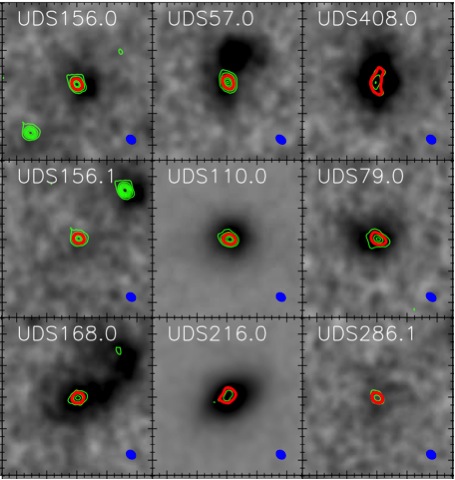
5 x 5 arcsec images of a sample of SMGs from the Simpson et al study. ALMA 870 micron contours (green) are superimposed on K-band images (greyscale) of the galaxies. The red contour designates where the surface brightness is 50% of the peak value.
[click to enlarge]
The extent of the star-forming regions in high-redshift submillimeter galaxies (SMGs) is a subject of hot debate. Prior studies have led to mixed results, measuring half light diameters (d) of a few to 10 kpc – by comparison, local galaxies with similar infrared luminosities have d ~ 1-2 kpc. Some of the dispersion in sizes likely results from a combination of sample selection, physical differences in what is being measured – e.g., CO line emission versus radio emission – and the assessment of physical sizes at the limit of a telescope’s resolution.
In a study by J. M. Simpson (Durham) and his collaborators, the authors make use of high-resolution (0.3 arcsec) ALMA 870 micron imaging observations of 52 SMGs from the Ultra Deep Survey field to assess their far-infrared extent and morphology. They measure a median d ~ 2.4 ± 0.2 kpc, which is half of measured radio sizes from a Multi-Element Radio Linked Interferometer Network – Very Large Array study of SMGs, and four times smaller that the measured rest-frame optical sizes. The authors attribute the larger radio sizes to the diffusion of cosmic rays from star-forming regions. They combine their measured sizes with far-infrared derived star formation rates to calculate a median star formation rate surface density of 90 ± 30 M⊙/yr/kpc2. The surface density values are less than the Eddington limit in which radiation pressure on dust grains in optically thick environments is the dominant feedback against the molecular disk's self-gravity. The authors conclude by discussing their results in the context of the transformation of SMGs into present-day elliptical galaxies.
A GBT Spectral Survey of Orion-KL at 67 - 93.6 GHz
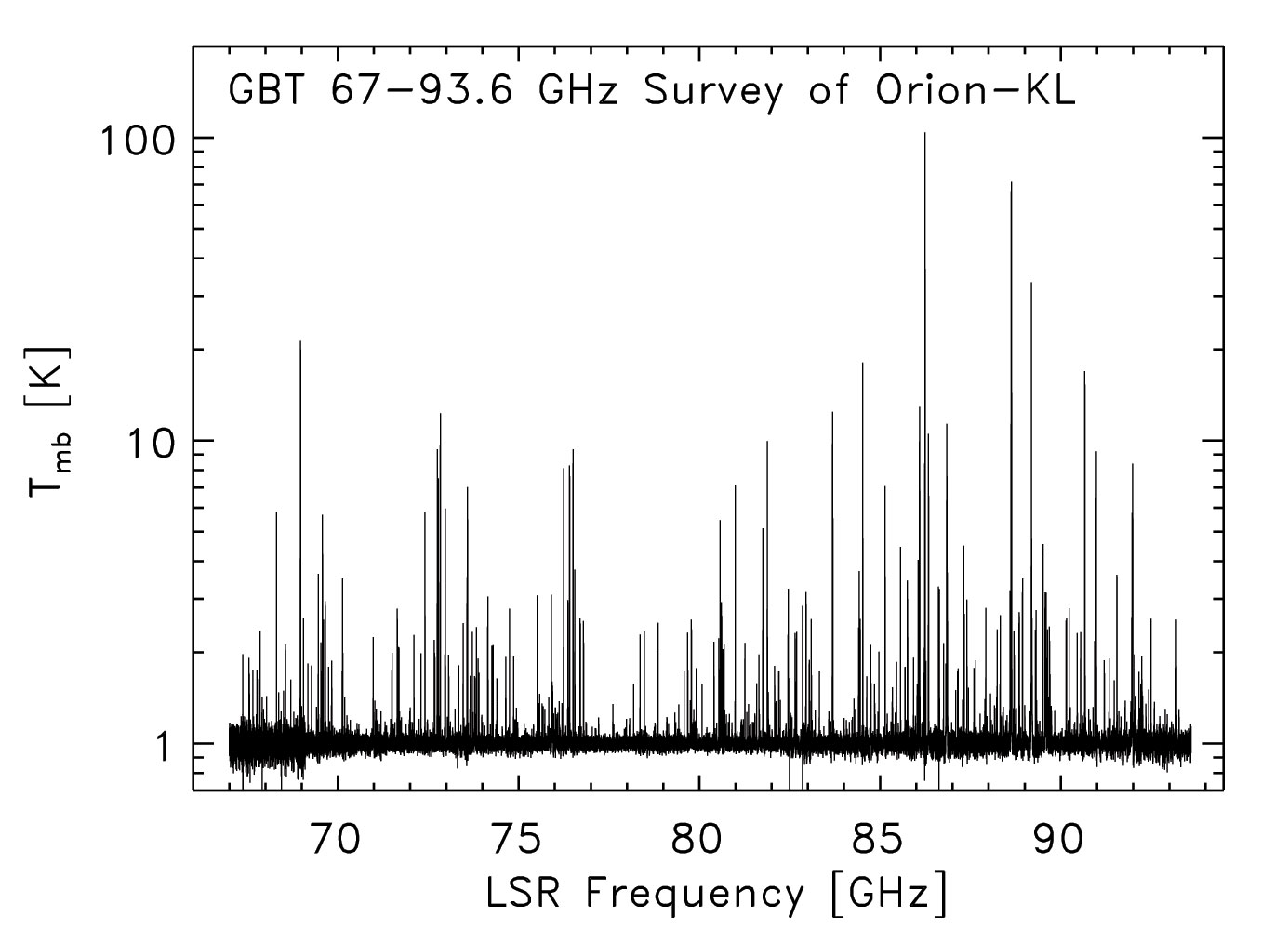
The 67-93.6 GHz spectrum of Orion-KL taken with the GBT. The spectrum has been shifted by +1 K for plotting on the logarithmic scale.
[click to enlarge]
The Orion Nebula is one of the most studied objects in the entire sky; within it, the Kleinmann-Low (KL) nebula has a rich and complex chemistry. A number of spectral surveys have been conducted to understand the chemistry and physical processes in star-forming regions like the KL nebula. Surveys at 1mm and shorter wavelengths are complicated by line confusion, but within the 3mm atmospheric window, confusion is less of an issue and this band contains many fundamental ground-state transitions of key molecular species.
The Green Bank Telescope (GBT), with its new 4mm receiver, has been used to make a spectral survey of the KL nebula over the frequency range 67-93.6 GHz. With its large collecting area, accurate surface, and the excellent performance of the 4mm receiver, the GBT 4mm system is the world’s most sensitive telescope in this band. In fact, at frequencies where it overlaps with ALMA Band 3, the GBT system can achieve better system temperatures in spite of the higher opacity associated with the lower elevation of Green Bank.
The GBT spectral survey was made with a velocity resolution ~1.5 km/s and angular resolution ~10 arcsec. Lines with main beam temperature Tmb > 1 K are tabulated but many as weak as 10 mK are identifiable in the data. The survey paper has been accepted for publication in the Astronomical Journal.
Reference
Frayer, D. T. et al., The GBT 67-93.6 GHz Spectral Line Survey of Orion-KL, 2015 Astronomical Journal, in press.
ALMA Program Update
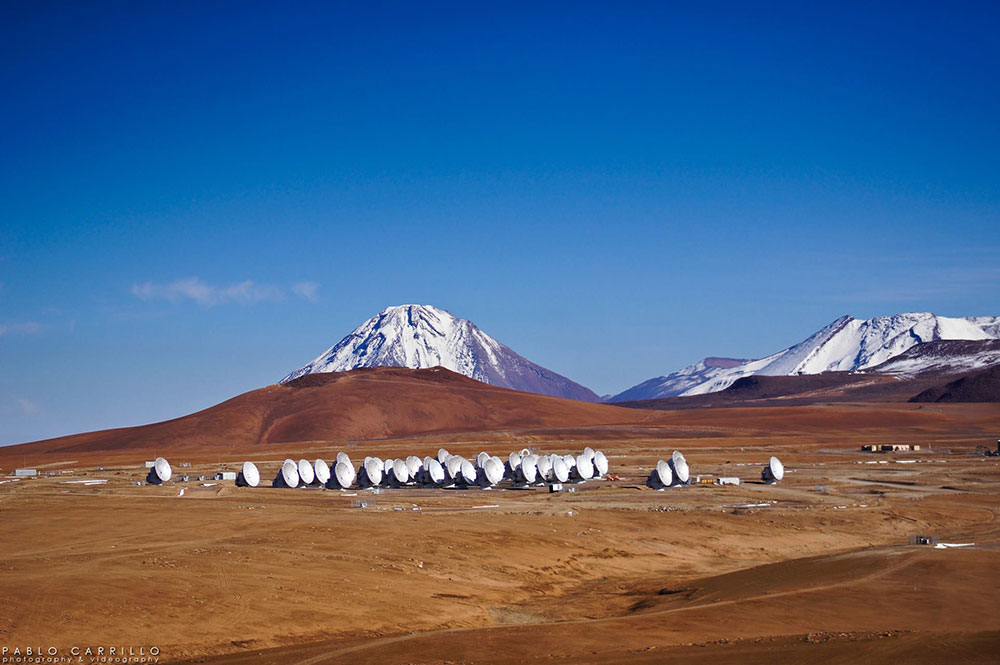
P. Carillo - ALMA (ESO/NAOJ/NRAO)
64 ALMA antennas clustered in their compact array in February 2015.
[click to enlarge]
ALMA's antennas continued observations in a compact configuration, a hybrid of C34-1 (~1.6" resolution at 1.3mm) and C34-2 (~0.9" resolution at 1.3mm), until observations were paused February 2015 for engineering on the array. Observations will resume 31 March, as previously announced, with antennas remaining in the compact C34-1 configuration.
ALMA saw deteriorating weather as the observing period closed, but data collection rates continued to be excellent during the increasingly shorter observing windows. Interested parties may monitor the status of the array via the new ALMA Status Page.
The Cycle 3 Call for Proposals will be posted 24 March 2015 for a submission deadline of 23 April 2015. An observing update will be posted on the ALMA Science Portal to aid investigators in assessing the status of their current projects.
NRAO Community Day Events (CDEs) are being planned for various locations around the United States to aid investigators in preparing Cycle 3 proposals for submission to ALMA.
The recent pause in observing offered an opportunity to reflect on ALMA's year, which included the following highlights:
- The end of ALMA construction and the assembly, integration and verification (AIV) program, and deployment of Band 4 (2mm), Band 8 (0.6mm), and Band 10 (0.35mm) on the array for Cycle 3.
- The commencement of Cycle 2 Early Science, for which more proposalswere received than for any other astronomical telescope at a single Call.
- The successful delivery, acceptance, and implementation of the requisite infrastructure for long baseline observations.
- New outstanding Science Verification data delivered by the ALMA Long Baseline Campaign and its release via the ALMA Science Portal.
- Two ALMA Development Projects moved to implementation:
- The first Very Long Baseline Interferometry (VLBI) observations were recently conducted with ALMA (see the next article); and
- A fiber pathway was completed for data transmission from the Array Operations Site at Chajnantor to the Joint ALMA Observatory offices in Santiago.
A new Call for ALMA Development Studies will be issued for ALMA North
America on 16 March 2015.
ALMA VLBI 'First Light'
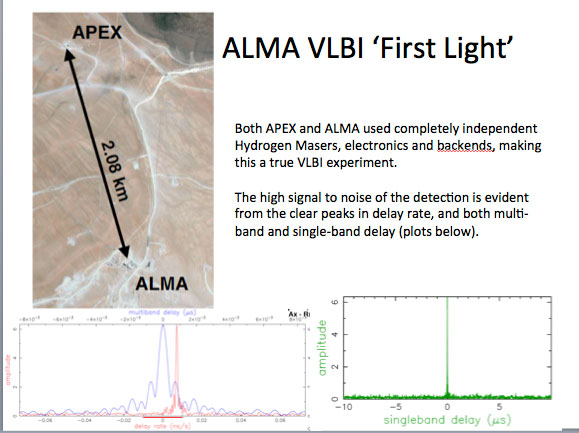
[click to enlarge]
On 13 Jan 2015, a team including members from the ALMA Phasing Project (APP), the Joint ALMA Observatory (JAO) and the Atacama Pathfinder Experiment (APEX) telescope made the first Very Long Baseline Interferometry (VLBI) observations at 1.3mm with ALMA. Over a ~2km baseline between ALMA and the APEX site, the successful detection of quasar 0522-364 verified major components of the new ALMA Phasing System. This detection was obtained using only 5 seconds of data, sent via Internet from Chile to the Massachusetts Institute of Technology (MIT) – Haystack Observatory VLBI correlator. A full analysis will follow once VLBI disk modules with more data from the observations arrive at MIT.
Both APEX and ALMA used completely independent hydrogen masers, electronics, and backends, making this a true VLBI experiment. The high signal to noise of the detection is evident from the clear peaks in the delay rate for both the multi-band and single-band delays.
CASA News Debuts
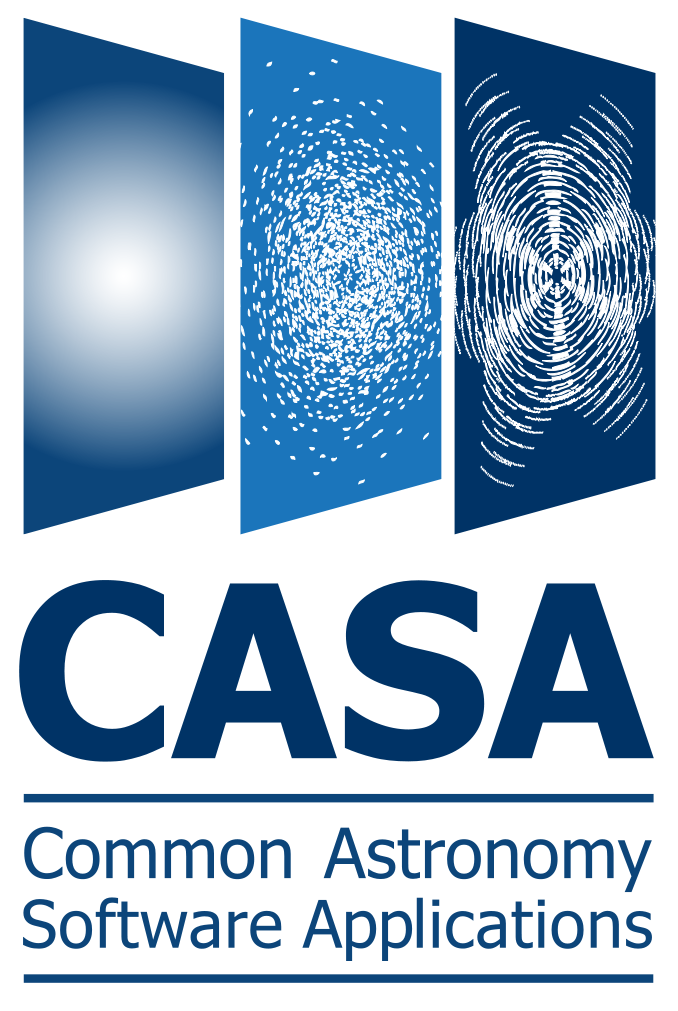
The first issue of a new Common Astronomy Software Applications (CASA) newsletter – CASA News – is now available. This semi-annual publication is designed to provide the CASA user community an understanding regarding what the CASA team is working on and details about astronomical data processing using CASA.
To receive future CASA News issues, please subscribe via the CASA Announcements mailing list.
2015 CASA User Survey
The CASA team is conducting a user survey to better understand the CASA community. The results of this survey will be used to prioritize developments in upcoming CASA releases and to better optimize our algorithms and architecture in line with the issues confronting our users. Even if you are not a frequent user of the CASA package, we would like to hear from you.
To participate in the CASA User Survey, please visit the Survey website no later than Wednesday, 18 March 2015. The survey is anonymous and takes only about 10 minutes to complete.
Recent Media Releases
Career Opportunities
New Postings
Technical Manager- Telescope Maintenance: The NRAO in Green Bank, WV is now accepting applications for a Technical Manager. Working with the Division Head and the Technical Manager of Operations, the candidate will implement maintenance strategies to achieve individual site telescope science objectives. Candidate will direct the work of 3 to 5 craftsmen. The manager for the maintenance group solicits, interviews, and recommends the hiring of 15 to 20 seasonal workers for painting and mechanic work, then plans and supervises the seasonal work. Develops work schedules for the group, and assures that they are aware of required and recommended safe work practices.
Grant and Contract Administration Officer: Associated Universities, Inc. (AUI) is now accepting applications for a Grant and Contract Administration Officer. The Grant and Contract Administration Officer will enhance the capacity of AUI to oversee sponsored research funding and administration, facilitating the implementation of new processes and systems to achieve AUI’s goal of expanding research activities at AUI and its research centers.
Technical Specialist II: The NRAO in Socorro, NM is now accepting applications for a Technical Specialist II. Under general supervision from engineers, this position devises, lays out, fabricates, calibrates, tests, analyzes, troubleshoots, and/or repairs astronomical research related equipment such as cryogenic microwave frontend receivers and associated hardware. Work performed is moderately independent. This is the middle level of three progressively more complex positions.
Safety Officer: The NRAO is now accepting applications for a Safety Officer in Socorro, NM. The Safety Officer is responsible for ensuring compliance with applicable Federal, State, and local Environment, Safety and Security (ES&S) regulations for the NRAO at the VLA. Provide the management, presentation and implementation of Safety and Health Programs that maintain employee awareness.
Observatory Scientist: The Joint ALMA Observatory (JAO) is seeking an Observatory Scientist with extensive experience for coordinating and organizing scientific activities at the ALMA radio astronomy observatory in Santiago, Chile. The Observatory Scientist will provide ongoing scientific leadership for astronomy staff, and continue to lead the efforts to maximizing the scientific performance and impact of the array through continued improvement including, but not limited to, the development program.
From the Archives
Ellen Bouton

[click to enlarge]
About this month's photograph: The surface accuracy of NRAO's 36-foot telescope in Tucson, which began operation in January 1968, fell significantly short of design specifications. In summer 1975, after measuring and mapping the surface to produce a contour map of surface errors, removing the surface paint, projecting the map onto the surface, and marking the contours on the aluminum surface, staff attempted to correct imperfections in the surface by "foiling the telescope." They filled surface "holes" with layers of 0.005-inch thick adhesive aluminum foil. Corrections were less effective than expected. Later, the basic problem turned out not to be imperfections in the surface of the reflector but, rather, that the shape distorted with temperature (aluminum structure attached to a steel support structure – bimetallic strip effect) and also with gravity as the reflector tilted. Uncorrectable defects were part of the impetus for replacing the 36-foot reflector with a new 12-meter reflector. In this photo, John Payne (at left, in plaid cap), Paul Rhodes (right), and Victor Gasho (back to camera, behind Paul) are hard at work attaching the adhesive foil. Thanks to Mark Gordon for help with this caption. For more on the "foiling," see the article beginning on page 6 of The Observer for October 1975.
From the Archives is an ongoing series illustrating NRAO and U.S. radio astronomy history via images selected from our collections of individuals' and institutional papers. If readers have images they believe would be of interest to the Archives, please contact Ellen Bouton.

